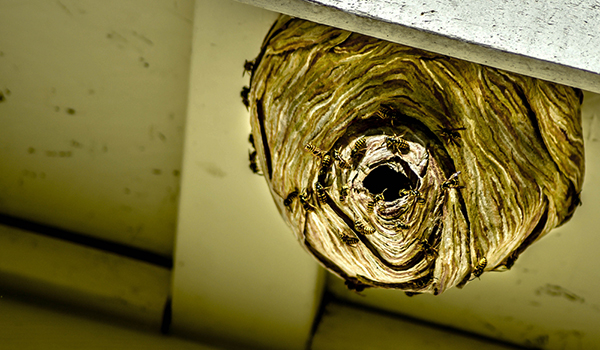How to Remove a Wasp Nest
Author: Barbara Horwitz-Bennett | September 6, 2023
With a warm spot out of the rain and access to food, the roof of your home is an attractive place for wasps to nest. Not only can they cause damage by chewing up wood materials from your home to build their nest, but there's also the threat of their painful stings.
Knowing how to remove a wasp nest is important information for homeowners.

Finding the Culprit
Naturally, the first step in addressing your wasp issue is locating the nest. Carefully tracking wasps to see where they lead you is one strategy. Otherwise, one common place to look is in the eaves, which is part of the roof that meets or overhangs the walls of the house. Additionally, wasps tend to build nests in the walls, under a window sill or in attic rafters. Different kinds of wasps build different kinds of nests: Paper wasps may hang their homes from the edge of your gutters, while mud dauber wasps may build their tube-shaped nests under a porch roof. (It's worth noting that this second kind of wasp is much less aggressive and unlikely to sting.)
Don't let a wasp nest grow and grow over the summer. Start the removal process as soon as you notice insects entering or leaving your home.
It is best to bring in a professional to remove wasps, especially if a family member is allergic to bee and wasp stings or the nest is located in a hard-to-reach location. But if homeowners are set on addressing the issue themselves, there are a few important guidelines to follow.
How to Remove a Wasp Nest
First, it's important to know that wasps are aggressive insects, particularly when their home is threatened — and unlike harmless honeybees, they can sting multiple times. Consequently, the designated "wasp hunter" should wear protective clothing, including a long-sleeved shirt, long pants, socks, gloves, shoes, a hat, a face covering and safety goggles.
As the Western Exterminator Company notes, wasp removal should take place in the early morning or early evening to best ensure that all the wasps are dormant and inside the nest. Prior to approaching the nest with pesticide, you should seal off all entry points to prevent escape.
After spraying the wasps, the nest should be carefully removed, placed in a sealed bag, and then put inside a garbage can with a tight lid, preferably away from the house.
How NOT to Remove a Wasp Nest
To protect yourself from angry attacking wasps, avoid approaching wasp removal with fire, water or a tennis racket/baseball bat. Hazardous DIY methods such as flooding a nest or setting it on fire can damage your property and cause injury.
To proactively keep wasps away from your home, homeowners can carry out regular maintenance to ensure all cracks and potential entry points, such as gaps in brickwork, are caulked or appropriately sealed. Install fly screens on windows and doors to prevent wasps from entering your home. Finally, one virtually free trick is to place bottles partially filled with water and sugar to act as wasp traps around your garden.